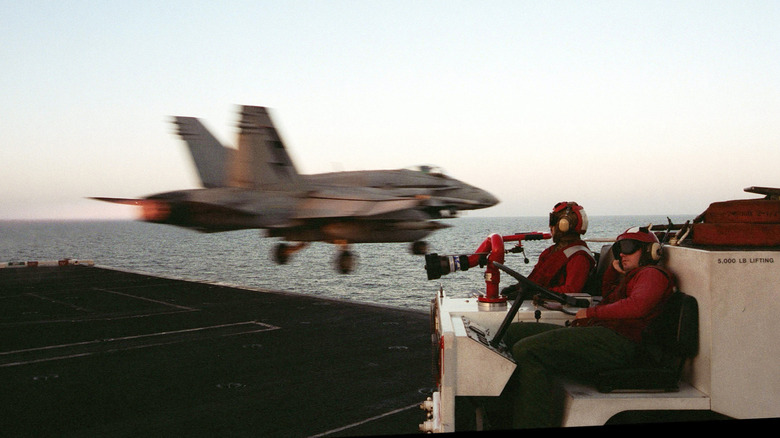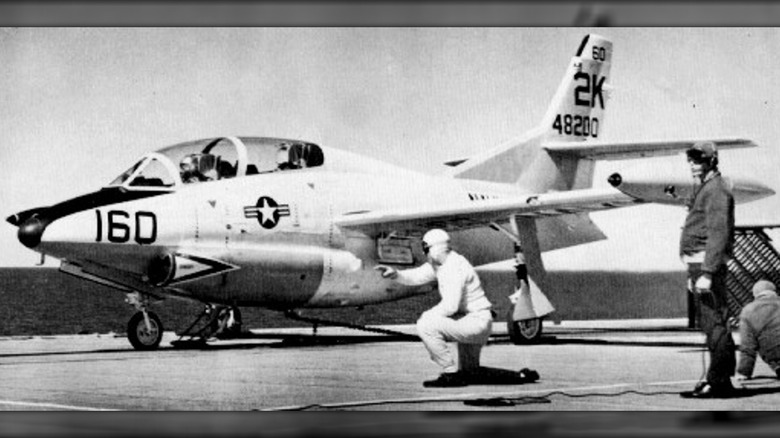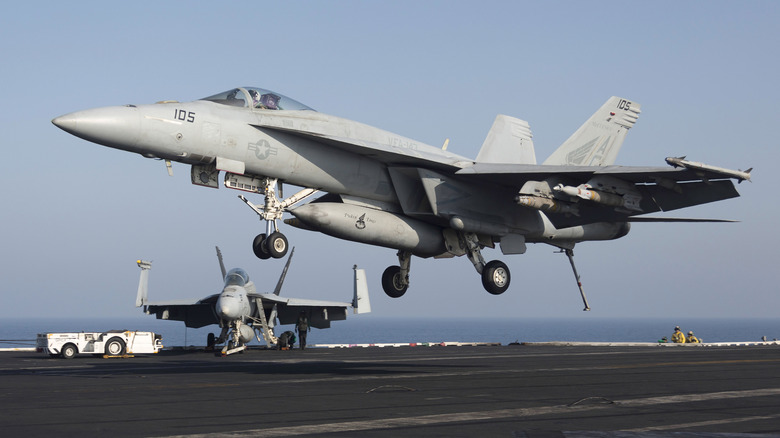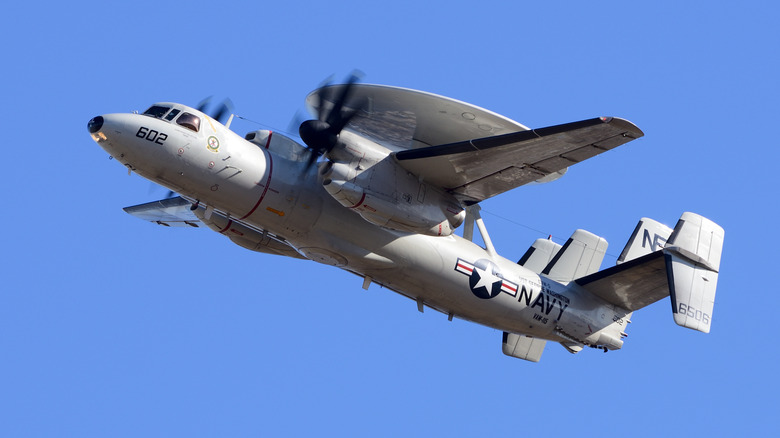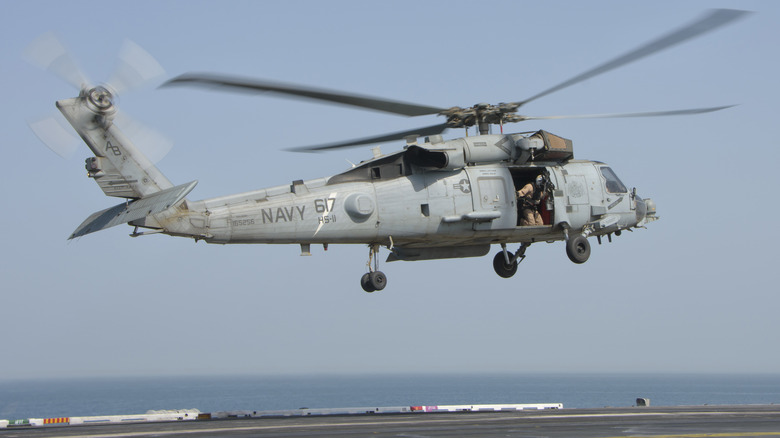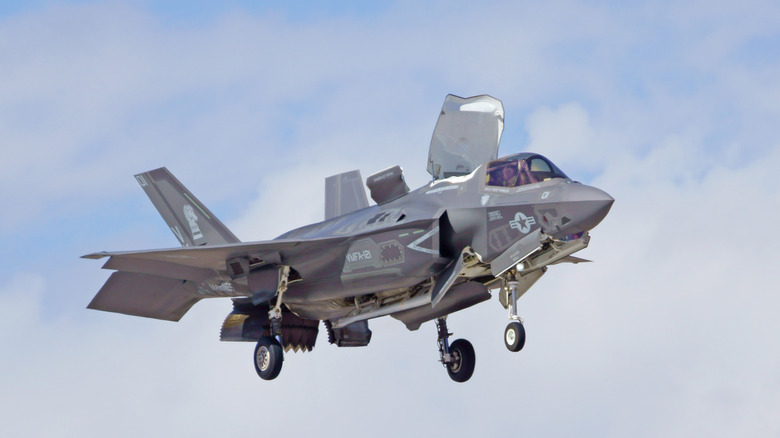The 5 Worst Launch And Recovery Failures On Aircraft Carriers
There are plenty of dangerous jobs in the United States military, and that's kind of the point. Those who serve in uniform put their lives on the line all the time, but few are as at risk as the people working on the flight deck of an active aircraft carrier. It's not hyperbole to say that the flight deck of an aircraft carrier is the "Danger Zone." It's all got to do with the launch and recovery of aircraft.
Jets flying off or landing on a carrier carry flammable fuel, bombs, bullets, and other things that can go "BOOM!" The people directing flight and recovery operations are endangered whenever something doesn't go right, and it happens more often than you might think. Whether a pilot doesn't land properly, the catapult launching them malfunctions, or any of a thousand other problems arise, it can be catastrophic for everyone involved.
There have been thousands of near misses and accidents on aircraft carrier flight decks over the years, going back more than a century. Instead of focusing on the worst launch and recovery failures from that time, this article focuses on the most dangerous accidents from the past few decades, beginning in the 1990s. Each instance was an accident, and they all resulted in significant damage, while some involved the deaths of some unfortunate few.
A T-2C Buckeye crashed after launch from the USS Forrestal
The T-2 Buckeye was a training aircraft used by the United States Navy and Marine Corps from 1958 until 2008, so it has some history. The twin-engine jet's tandem seating allowed for an instructor to fly with a trainee, and it was well suited for that purpose. The T-2C was the last variant made for the Navy, and it had an impressive safety record, seeing as it was used for training for half a century.
While several accidents befell the aircraft, one of the worst occurred on April 15, 1992. During a training mission, a T-2C took off from the USS Forrestal (AVT-59), crashing about 70 miles off the coast of Pensacola, Florida. The jet was being used for carrier qualifications when it plunged into the sea just after takeoff. The cause of the crash was never determined. Both the pilot and instructor ejected from the aircraft, initiating an immediate search to recover the two naval aviators.
The aircraft's instructor, Lt. Tim Fisher, who was assigned to Meridian Naval Air Station's Training Squadron 19, was rescued. He returned to the USS Forrestal uninjured and resumed his duties. The second aviator, whose name wasn't released, remained missing and was never recovered. The accident was the first to occur on the USS Forrestal since it was redesignated a training carrier earlier that year after finishing wartime duties during Operation Provide Comfort.
An F-14A Tomcat crashed approaching the USS Abraham Lincoln
The F-14 Tomcat was a twin-engine, two-seat fighter developed towards the end of the Vietnam War. Once it was introduced in 1974, it replaced the F-4 Phantom II as the U.S. Navy's primary tactical platform and defense interceptor. Throughout its service history, from 1970 to 2006, the F-14 was involved in 144 accidents, though few involved takeoff and landing from an aircraft carrier. The F-14A was the first model introduced in 1970, and one was involved in a deadly accident on October 25, 1994.
While approaching the USS Abraham Lincoln (CVN-72), an F-14A piloted by Lt. Kara "She-Hulk" Hultgreen, the first female fighter pilot to serve in the U.S. Navy, missed. She applied full power to one of her engines, causing the left engine to stall. This forced the aircraft to roll into the sea. Lt. Matthew Klemish, the aircraft's Radar Intercept Officer (RIO), ejected horizontally as the F-14 fell, which saved his life.
Lt. Hultgreen ejected, but by the time her ejection was initiated, the aircraft rolled to face down. She ejected directly into the water, killing her instantly. Investigations faulted mechanical malfunctions as the cause of the crash, while the Mishap Investigation Report (MIR, now called Safety Investigation Reports, SIR) determined pilot error as the primary factor in the accident. When the accident was made public, some decried female aviators as being unfit to fly fighters, though time has proven this determination ridiculous.
An E-2C Hawkeye crashed taking off from the USS Harry S. Truman
The E-2 Hawkeye is a tactical Airborne Early Warning (AEW) Command and Control (C2) aircraft used to identify aircraft, ships, missiles, and any potential threats to the fleet. This is accomplished via an array of radar and radio communications interception that's relayed to its launch carrier. Since its introduction, several variants emerged, including the E-2C, which included updated electronics and other advances in technology to keep pace with emerging threats.
The E-2 has been flying since 1960, and in all the time it's taken to the skies, the aircraft has been involved in 37 accidents. A particularly bad one occurred on August 15, 2007, during a takeoff from the USS Harry S. Truman (CVN-75). The E-2C Hawkeye was conducting a training flight with three occupants but it crashed shortly after takeoff, around 150 miles off the coast of Virginia. An immediate search was conducted to rescue the three aviators, which took a full day.
The cause of the crash was never determined, and none of the three occupants were found. The Navy declared them deceased the day after the crash, with only debris from the aircraft having been found. The E-2C was being used for carrier qualifications, which involve taking off and landing on an active aircraft carrier, though it's unclear what caused the E-2C to plummet into the ocean shortly after departing the carrier's flight deck.
An SH-60 Seahawk crashed after takeoff from the USS Ronald Reagan
When people think of aircraft carriers, they often picture fighter jets taking off and landing, but there's more going on than that. The SH-60 Sea Hawk is the workhorse helicopter of the U.S. Navy, based on the Army's UH-60 Black Hawk. The SH-60 is a reliable helicopter with a decent safety record, though the aircraft has been involved in 411 accidents since it first flew in 1982. A particularly bad crash involving takeoff from a carrier occurred on October 19, 2018.
That day, an MH-60R Sea Hawk, which the Navy uses for anti-submarine warfare and other missions, crashed during takeoff from the USS Ronald Reagan (CVN-76) during operations in the Philippine Sea. Fortunately, the crash didn't result in any fatalities, but 12 personnel were badly injured, and the helicopter was destroyed. It's unclear what caused the helicopter to drop onto the flight deck just after takeoff, but the damage was significant, as the helicopter itself was declared a loss.
The Navy didn't identify the people injured, but noted that eight personnel on the carrier were hurt, in addition to four aboard the helicopter. At the time of the crash, the helicopter had 16 personnel aboard, two of whom were the aircraft's pilot and copilot, though it wasn't made clear if they were among the injured. The Navy revealed that the injuries included lacerations and fractures, with two sailors being "seriously injured," but gave no further details.
An F-35 Lightning Crashed on the USS Carl Vinson
The F-35A Lightning II is one of the most advanced fighter jets in the world. Since its first flight in 2006, F-35s have been involved in 21 accidents as of October 2024. Of these accidents, only one resulted in a fatality, during operations of the Japan Air Self Defense Force (JASDF). While fatalities are fortunately rare, F-35 accidents are significant, as the aircraft are incredibly expensive and relatively new to the U.S. Navy, Air Force, and Marine Corps.
One particularly devastating crash occurred on January 24, 2022, during a landing attempt on the USS Carl Vinson (CVN-70) while operating in the South China Sea. The aircraft missed and slammed onto the flight deck before skidding off and into the sea. The pilot safely ejected and survived the incident, which resulted in six people injured, including the pilot. Five aboard the carrier were also injured, though everyone was able to walk away from the crash.
The investigation revealed pilot error as the cause of the crash, though not through any recklessness or ill intent. In terms of damage, it was significant, as the fighter was lost and it caused $120,000 in damages to the Carl Vinson's flight deck. Additionally, a nearby EA-18G Growler was struck with debris, causing $2.5 million in damages. The F-35C was recovered from a depth of 12,400 feet, though returning it to service was not an option.
